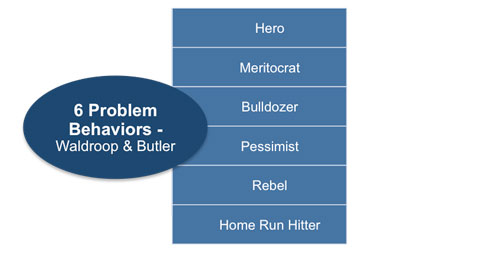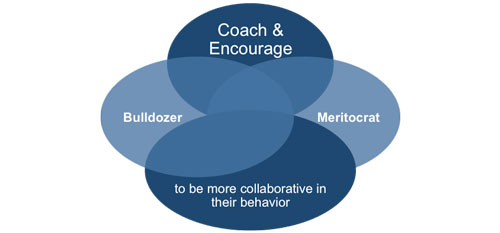Waldroop and Butler's Six Problem Behaviors
Management would be a lot easier if everyone just behaved how you wanted them to at all times. Of course, that is a pipe dream. Management, and leadership, are the important roles that they are because people are hard to predict. Even when it isn't in the best interest of the team, or even themselves, employees often exhibit behaviors that you wish they wouldn't. As a manager, it is your job to steer them back in the right direction without coming across as a dictator at the same time. It is a difficult balance to strike, but that is the challenge that you are given when you accept a leadership role.
Waldroop and Butler have aimed to help managers everywhere by identifying six of these 'problem behaviors' along with their traits. When you see any of these six starting to become present in members of your team, taking quick action is the best option before their behavior becomes a detriment to the group as a whole.
 |
The Hero
The hero is an easy one to spot, and it might not seem like such a bad thing at first. This is the person who is going above and beyond what is expected to try and get the job done. However, there can be such a thing as trying too hard, and it can be detrimental in the end. If you have a 'hero' personality on your team, you will need to watch out to make sure that they aren't burning themselves out - or burning out the people around them. Naturally, this is a tricky situation as a manager, because the last thing you want to do is discourage them from achieving great things for themselves and for the organization. Having conversations about good work-life balance is a place to start, just to make sure they understand that while you appreciate their efforts you are also concerned about their long-term career success.
The Meritocrat
Have you ever had a team member within your organization who felt like they were always right and didn't want to waste time explaining their decisions to you? That person would fall under the category of a meritocrat. This problem behavior is a challenge because this person feels like they are above the rest of the team, and their ideas should just be used without any discussion or debate.
The difficulty here for a manager is that the person may in fact be right - so you don't want to squash their ideas just because of an abrasive personality. However, for the betterment of the team as a whole, you will need to coach them into working more collaboratively with the rest of the team. Only when they are willing to engage in real discussions with other members of the group will their ideas really be welcomed and accepted.
 |
The Bulldozer
The profile of a bulldozer personality in the office isn't radically different from the meritocrat outlined above. As the name would indicate, the bulldozer is someone who is going to make enemies along the way just through their blunt and aggressive style. Again, like the meritocrat, a bulldozer might be a valuable employee that brings plenty to the team - although they make everyone else angry at the same time. Being able to walk the line between this employee and the rest of the team is a challenge, so make sure to work with the person who is showing bulldozer tendencies and try to soften their approach a little bit.
The Pessimist
This one should need very little introduction. A pessimist on your team is going to think that every idea is a bad one, that every new initiative will fail, that there isn't enough time to finish, etc. This person can be harmful to the team because their negative attitude can spread and pretty soon the rest of the team will share this bad outlook. Even if the pessimist has good intentions and actually is a hard worker, their attitude alone can turn them into a liability within your group. When dealing with this situation, it is important to get to know the person and figure out why it is that they are so negative in the first place. As long as they are willing to work on their outlook and try to see things from a more moderate perspective going forward, the pessimist could go on to remain a valuable member of the team.
The Rebel
There are certain people that just love to go against the grain. In some respects, the only thing they actually have a problem with is conformity itself. You might have one of these people within your team - called the rebel by Waldroop and Butler. Dealing with a rebel is particularly challenging because it might not be clear exactly why they are complaining or what they would like to see done differently. They do need to be addressed, however, because this kind of attitude can be counter-productive in terms of developing your team and reaching your goals. Not everything about a rebel is a bad thing. Having people within your team who aren't afraid to challenge authority and think for themselves is sometimes better than having a group of 'yes men'. When kept under reasonable control, someone with a slightly rebellious attitude can actually be an asset.
 |
The Home Run Hitter
The final behavior problem on the list is known as the home run hitter. As you would guess, this is a person who is always looking to make a big splash - even if they are overstepping their bounds or making choices that might not be in the best interest of the team as a whole. Patience is something that isn't usually exhibited by a home run hitter personality, so they may need to be coached into understanding their role as part of the team. As with the hero personality, having home run hitters on your team can be a great thing as long as they have enough discipline and accountability to not push it too far.
You may also be interested in:
Mintzberg's Management Roles | Lencioni's Five Dysfunctions of a Team | Birkinshaw's Four Dimensions of Management | Waldroop and Butler's Six Problem Behaviors | Cog's Ladder | Leader-Member Exchange Theory | Belbin's Team Roles | Benne and Sheats' Group Roles | Margerison-McCann Team Management Profile | The JD-R Model.



